Burning Man Art Project: 2003
Last updated: July 13, 2003
This web page is a project log for our
Burning Man 2003 art project.
I'll add entries at the bottom from time to time.
Here's the similar page for the
octavepus project last year.
Return to Tom Davis' home page.
You can click on any image on this page to see a larger
version.
Feb 2: The Flicker-Tron
Well, that's what we're calling it for now. The idea is to
make lines of LEDs, all computer controlled, arranged vertically
and spun so that each one sweeps out a cylinder. The result will be
a series of concentric cylinders of light (maybe "Light Cylinder"
would be a good name?).
If we can make the lights come on at the same points each time the
cylinder rotates, persistance of vision should make the whole thing
look like a sort of holograph.
It looks like each set of 8 LEDs will be controlled by a PIC chip
(currently PIC16F628) and all the PICs will be controlled along
a serial line on which the main processor will issue instructions.
The PICs plus the LEDs will thus be a sort of 3D framebuffer.
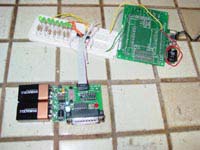
First Test
Here is a proto-board layout of 8 LEDs, PIC, PIC programmer, and
power supply. (The power supply is the only working part of a board
I fried last year working on that year's Burning Man project.) The
power supply is to the right of the proto-board and the Epic PIC
programmer is below, powered by two batteries. It is normally
cabled to a laptop where the PIC code can be written and assembled.
Test Board
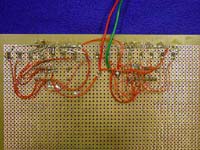
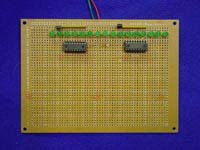
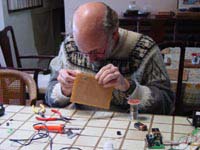
Here's the first attempt to see what the printed circuit boards might look
like. We've put two modules on a board to be able to test synchronization
of the PICs. On the left is me wiring it up, then there's a view of the
top and bottom of the board.
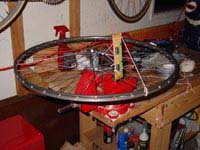
Bicycle Wheel Test
Here's the test board cut narrow and mounted on a bicycle wheel. If you
turn out the lights and spin it, you can see ghostly patterns in space.
What we learned is this:
- The wheel will probably need to turn at about 10 revolutions per
second to get sufficient persistance of vision.
- It would be nice to have brighter LEDs. (This should be easy.)
- The on-board clocks of the PICs differ quite a bit in speed, so
we'll have to have some way either to clock them at the same time, or
to resynchronize regularly, or both.
July 13: Newer Design
I finally got back to this. There have been a lot of discussions
about how the thing should work, and now we're thinking of a single
sheet of light, but for only a 2D image.
We also counted the states, and realize that we'll almost certainly
need one PIC chip for every 4 lights instead of every 8. Today I
rewired the board so we can test it and if it works, make some
printed-circuit boards. On this version I also added wires for
clock and communication -- interrupts, transmit, receive, and clock.
Here are photos of the rewired board:


We have settled on at least one thing. The name is
"The Flickertron", all one word.
Want to send me mail? Click here: tomrdavis@earthlink.net.
Return to my home page.




